3 Things Your Proposals Need Now in 2021
Published: January 5, 2021Updated: April 11, 2024

How To Future-Proof Your Proposals: 3 Things Your Sales Docs Need Now (and Always)
Even in a weird year like 2020, more than half of all sales teams still hit quota. What were they doing that those other teams weren’t? According to sales leaders from LinkedIn, HubSpot, and Gong, the teams that won more deals embraced three vital things in their sales process. Here’s how to use them in your proposals to reach your revenue goals in 2021 and beyond.
Me, sitting down to write the first post of 2021: “Oh, a trends post would be fun! I could give an update on the proposal trends post I put together last year, which had lots of good info in it.”
Also me, sitting down to write the first post of 2021: “Predictions? In this climate???”
What’s the opposite of trends and predictions? Knowing what works and doubling down on those things. This post is all about timeless things that future-proof your proposals and keep them closing long after any fads fade away.
Sure, the exact methods for how you include these three key things might evolve. For example, in the past a logo might’ve been all you needed to nail the first one. But rest assured the concepts in this post are as solid as that holiday fruitcake your Great-Aunt Fran insists on sending every year.
And, just so you know I’m not nuttier than a you-know-what, these are also things that sales leaders from global companies are focusing on within their own teams.
So why these particular things? And why now? Because though they’re kinda trending right now, they also embrace the fundamentals of why and how people buy. Maybe that’s my prediction for this year: we’ll go back to the basics that’ll take our proposals into the future.
There’s no time to waste, so let’s jump in.
3 things your proposals need now and into the future
A recent HubSpot sales enablement report found that 40% of sales teams missed targets in 2020. Oof. While that stings, it’s also not surprising, given the amount of economic uncertainty over the past year.
Yet, if you flip the statistic, it means that more than half either met their revenue goals or even outperformed them. What were those sales leaders and their teams doing differently? According to sales pros from LinkedIn, HubSpot, and Gong, sales teams that were successful in 2020 embraced three specific things throughout their sales process:
So why not make them the stars of your proposals in 2021? Here’s how.
1. Trust
“As the world shifts to virtual, the challenge is building trust with your prospects and cutting through the noise.” - Alyssa Merwin, VP of Sales, North America, at LinkedIn
There is so much noise out there. How can you make your proposal stand out? By building trust.
Let’s start with a B2C example. Say you’ve been itching to buy a certain product. You look up the product on a huge online retailer’s site.
The best deal is from a company you’ve never heard of, one with a handle like the owner’s cat wandered across their keyboard at a critical brand-naming point. A blurry image, a vague description, and sketchy reviews complete the listing.
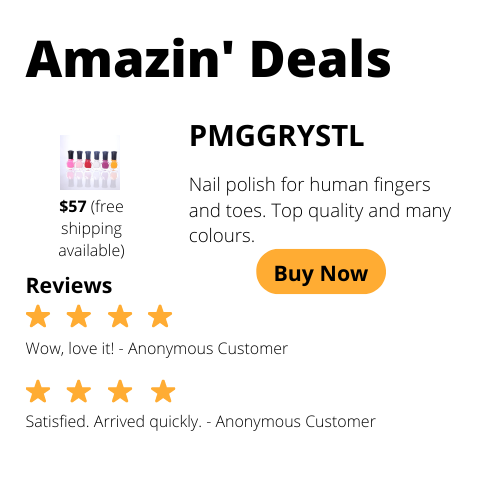
Unsure, you click over to a local retailer’s online shop. They have a similar product, also from a company you’re not familiar with. Yeah, it costs a bit more here, but you could skip shipping and simply pick it up. Plus, their listing features multiple high-quality photos, a video of someone using the product, and thorough descriptions and buyer reviews.
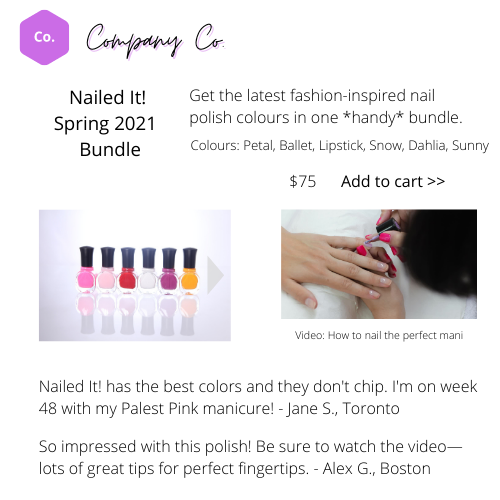
Which one would you buy? And why?
Your buying decision likely boils down to trust. If you don’t have that brand-name recognition as a leader in your category, you’re going to have to work a bit harder to gain buyers’ trust. That means that your proposals have to work harder on this aspect, too.
That second image up there may look like a completely made-up nail polish product listing (because it is), but it also contains everything you need to build trust with your proposal. Let’s dive into three of them:
1. Social proof
Social proof is a great way to build trust with your prospects. The most popular way to do this is to add a case study or two to your proposal. Case studies show how other customers have found success with your product or service.
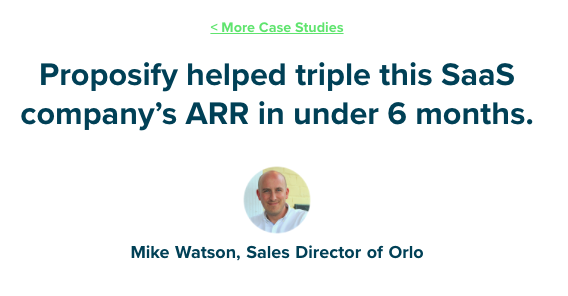
But there are other things that can be just as convincing for your prospects, if not more. Check out this post for seven more ways to include social proof in your proposal, from non-sketchy reviews to exclusivity, plus examples of how to get them right.
2. Brand consistency
Do your sales cycle components look like this?
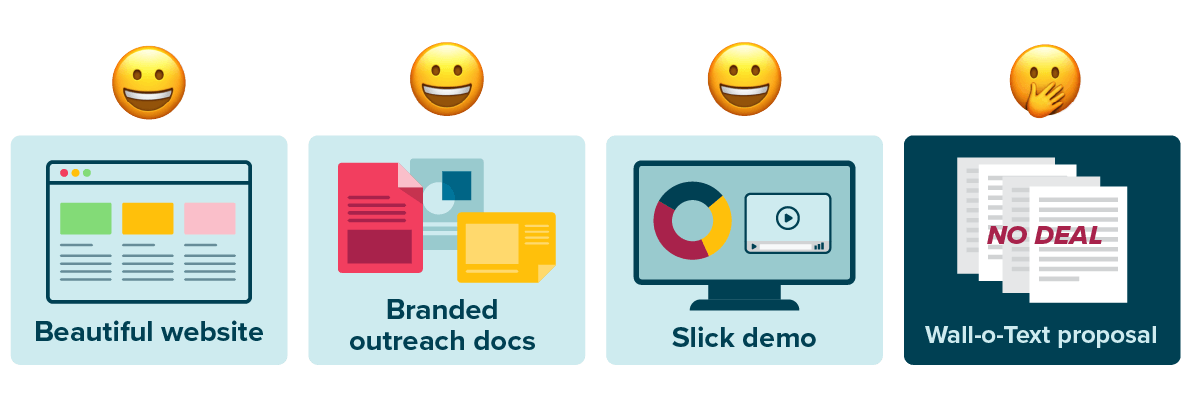
Prospects visit a well-designed website, maybe receive a branded one-pager, join in on a slick customized demo and then, BAM. At the most crucial point, the close, all that branding and design falls away in the form of a bland, wall-of-text proposal full of legalese
This kind of disconnect can kill deals. It erodes trust and makes it harder for your leads to say yes. Check out this post for three ways to make sure your proposals provide a consistent customer experience.
3. Images and video
Did you know that including images in your proposals can increase your close rate by 23%? Plus, in some industries, like SaaS (software as a service) and event services, video can more than double proposal close rates.
With even more teams harnessing the power of visuals for their sales and marketing efforts—Vidyard’s State of Video 2020 report shows that video creation has increased more than 250% over the past 12 months—this is no time to be behind the times.
If those stats can’t convince you, I’m not sure what else I can tell you. Unless you haven’t been using these close-rate superchargers because you’re worried about trying to format a photo or video into your Word doc or PDF.
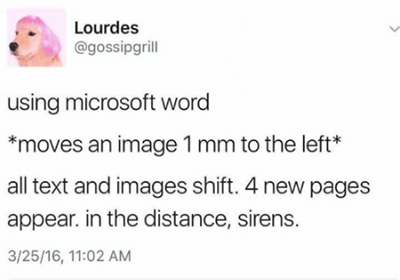
Proposal software is built for modern proposals with modern elements like images and video.
2. Customer experience
“As you plan your 2021 and beyond, sharpen your focus on your customer.” - Yamini Rangan, Chief Customer Officer at HubSpot
As Yamini says, customers need to be at the centre of every decision you make. Successful sales teams can no longer settle for self-interest and rest on doing what works for them. It might be easier for your team to send the same boring boilerplate Word doc proposal for every deal but is that what’s best for the prospect?
Your sales team needs to be dialled in on how people want to buy now and make sure all your sales documents, including your proposals, are helping, not hindering, them along the buying journey.
Here’s how to be prepared for the new breed of buyer:
Over the past few years, there’s been much chatter about buying committees and how that group influence over buying decisions has changed how sales teams close deals. Those committees haven’t gone away but now the focus is on the make-up of those groups.
Buying committees now include more Gen Z decision-makers. Born between the mid-90s and 2010s, they’re digital natives who expect both seamless online experience and brand experience, as I mentioned above. According to LinkedIn, they expect B2B buying journeys to recreate the experience of B2C ecommerce.
And it’s not just the ‘youths’ looking for these things. More remote work and greater reliance on tech tools have pushed their older generational cohorts Gen Xers and Boomers to up their online engagement and presence too.
No matter their generation, today’s buyer looks for convenience and customization. Sales teams can no longer cling to familiar but old-fashioned tech like faxing and PDFs. Which features does a new customer-centric proposal include?
- Customizable packages and clear pricing
- Quick credit card payment
- A mobile-friendly interface
- Easy-to-use electronic signatures
- All-in-one solutions, like in-proposal forms and commenting that reduce the need for time-consuming back-and-forth and meetings
Features like these are great but sometimes your sales rep is working with an internal champion and not the ultimate decision maker. All the oh-so-convenient forms in the world can’t help you if you’re unable to make the case to the person with the sign-off power.
One of our Proposify AEs, Will, has found success crafting handy videos that directly engage the DM. Here he is with more on this approach (and be sure to click through to his post to check out the example video he posted in the comments).
3. Data & automation
"The efficacy of our historical data was overturned when COVID hit in Q2 2020. Everything in the sales process as we know it changed, from buyer expectations to sales motions, increasing uncertainty for revenue teams." - Annelies Husmann, Director, Enterprise Sales, at Gong
Where I live, we have a saying: if you don’t like the weather, wait five minutes.
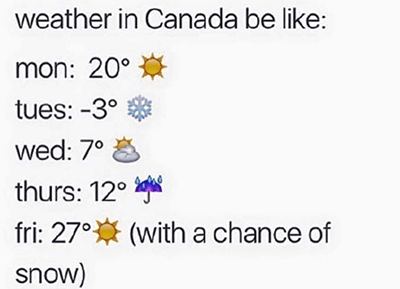
I feel like that’s what it must have been like trying to forecast deals in 2020. The changes kept rolling in, making the data that teams once relied on out of whack with the current climate. And it doesn’t help that many sales teams have metrics for every part of their sales process EXCEPT for the most important stage: the close.
How can you get better, real-time insights into what’s influencing your deals? Two words: proposal metrics.
Proposal metrics can give your team the specific deal-level details and pipeline-wide numbers they need to close. They get rid of the guessing game of sending sales documents. As Annelies points out, now that any historical sales data has been at least skewed, if not rendered useless, over the past year. However, the real-time metrics you can tap into via proposal software show you and your team exactly how prospects are interacting with your proposals right now.
Did they open it? How many times? How much time did they spend looking it over? Which sections did they spend time on? Were any sections skipped over or ignored? Knowing the answers to these questions helps your sales reps time their follow-up with precision and pinpoint the right questions to ask or information to provide to get the deal closed.
Of course, it’s a moot point to have this data if it’s not easily accessible or if you’re spending valuable time shuttling numbers and other details manually between tools and spreadsheets. Automation via CRM integrations (like Salesforce, HubSpot, or Pipedrive) with proposal software keeps your tech stack synced so you can create, track, and close deals within your CRM.
Winning now and in the future
It’s been an uncertain 12 months. The next 12 aren’t looking super clear either.
The good news is that we can look at what worked (and didn’t) in our own businesses and teams and in bigger businesses to see what we should focus on that will set us up for success now and later.
And, if I were to make a prediction for 2021, it would be that we’re all probably going to have to make pivots and updates as we go along. But getting these proposals foundations right will make it easier to make smaller tweaks as things change rather than starting from scratch every time.


